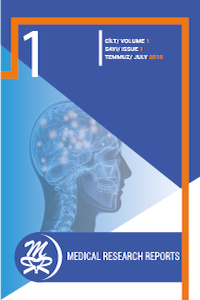ASSOCIATION BETWEEN COGNITIVE BELIEFS AND OBSESSIVE COMPULSIVE SYMPTOMS IN NON-CLINICAL POPULATION
ASSOCIATION BETWEEN COGNITIVE BELIEFS AND OBSESSIVE COMPULSIVE SYMPTOMS IN NON-CLINICAL POPULATION
Cognitive Beliefs, Obsessive Compulsive Symptoms, adolescent,
___
- DSM-5 American Psychiatric Association. Diagnostic and statistical manual of mental disorders, 5th ed. (Washington, DC: American Psychiatric Press, 2013).
- Goodman WK, Price LH, Rasmussen SA, Mazure C, Delgado P, Heninger GR et al.: The Yale–Brown Obsessive Compulsive Scale. II. Validity. Archives of General Psychiatry 46(11):1012–1016, 1989.
- Leckman, J. F., Grice, D. E., Boardman, J., Zhang, H., Vitale, A., Bondi,C., et al. (1997). Symptoms of obsessive–compulsive disorder. American Journal of Psychiatry,154, 911–917.
- Lewin, Adam & Park, Jennifer & Jones, Anna & Crawford, Erika & De Nadai, Alessandro & Menzel, Jessie & B. Arnold, Elysse & Murphy, Tanya & Storch, Eric. (2014). Family-based exposure and response prevention therapy for preschool-aged children with obsessive-compulsive disorder: A pilot randomized controlled trial. Behaviour Research and Therapy. 56. 10.1016/j.brat.2014.02.001
- Heyman, Isobel & Fombonne, Eric & Simmons, H & Ford, Tamsin & Meltzer, H & Goodman, R. (2001). Prevalence of obsessive-compulsive disorder in the British Nationwide Survey of Child Mental Health. The British journal of psychiatry : the journal of mental science. 179. 324-9. 10.1192/bjp.179.4.324.
- Storch, Eric & A Milsom, Vanessa & Merlo, Lisa & Larson, Michael & R Geffken, Gary & Jacob, Marni & Murphy, Tanya & Goodman, Wayne. (2008). Insight in pediatric obsessive-compulsive disorder: Associations with clinical presentation. Psychiatry research. 160. 212-20. 10.1016/j.psychres.2007.07.005.
- Farrell LJ, Waters AM, Zimmer-Gembeck MJ. Cognitive biases and obsessive–compulsive symptoms in children: examining the role of maternal cognitive bias and child age. Behav Ther 2012;43:593-605.
- Foa EB, Huppert JD, Leiberg S, Langner R, Kichic R, Hajcak G, et al. The obsessive-compulsive inventory: Development and validation of a short version. Psychol Assess 2002;14(4):485-96.
- Aydin A, Boysan M, Kalafat T, Selvi Y, Besiroglu L, Kagan M. Validation of the Turkish Version of the Obsessive- Compulsive Inventory-Revised (OCI-R) in Clinical and Non- Clinical Samples. Archives of Neuropsychiatry 2014;51(1):15- 22.
- Coles ME, Wolters LH, Sochting I, de Haan E, Pietrefesa AS, Whiteside SP. Development and initial validation of the obsessive beliefs questionnaire-child version (OBQ-CV). Depress Anxiety 2010;27(10):982-91.
- Boysan et al (2016) Psychometric Properties of Turkish versions of the Leyton Obsessional Inventory-Child Version (LOI-CV) and Obsessive Beliefs Questionnaire-Child Version (OBQ-CV), Klinik Psikofarmakoloji Bülteni-Bulletin of Clinical Psychopharmacology, 26:4, 382-396, DOI: 10.5455/bcp.20151203125902
- Bacow TL, Pincus DB, Ehrenreich JT, Brody LR. The metacognitions questionnaire for children: development and validation in a clinical sample of children and adolescents with anxiety disorders. J Anxiety Disord 2009;23(6):727-36.
- Irak M. Standardization of Turkish form of metacognition questionnaire for children and adolescents: the relationships with anxiety and obsessive-compulsive symptoms. Turk Psikiyatri Derg 2012;23(1):46-52.
- Spielberger CD. Manual for the State – Trait Anxiety Inventory for children Palo Alto: Consulting Psychologists Press; 1973.
- Ozusta S. Turkish standardization, reliability and validity of State Trait Anxiety Inventory for children. Turkish J Psychol 1995;10:32-44.
- Wheaton MG, Abramowitz JS, Berman NC, Riemann BC, Hale LR. The relationship between obsessive beliefs and symptom dimensions in obsessive-compulsive disorder. Behaviour Research and Therapy 48 (2010) 949-954
- Barrett P, Healy-Farrell L. Perceived responsibility in juvenile obsessive–compulsive disorder: an experimental manipulation Jour- nal of clinical child and adolescent psychology: the official journal for the Society of Clinical Child and Adolescent Psychology, 32. American Psychological Association, Division 53; 2003430-41
- Libby S, Reynolds S, Derisley J, Clark S. Cognitive appraisals in young people with obsessive–compulsive disorder. J Child Psychol Psychiatry 2004;45:1076-84.
- Farrell, L., & Barrett, P. (2006). Obsessive–compulsive disorder across developmental trajectory: Cognitive processing of threat in children, adolescents and adults. British Journal of Psychology, 97, 95–114.
- Wilson, Charlotte & Hall, Martin. (2012). Thought Control Strategies in Adolescents: Links with OCD Symptoms and Meta-Cognitive Beliefs. Behavioural and cognitive psychotherapy. 40. 438-51. 10.1017/S135246581200001X.
- Yayın Aralığı: Yılda 3 Sayı
- Başlangıç: 2017
- Yayıncı: M. Tayyib KADAK
AĞRI DEĞERLENDİRİLMESİ: TİPLERİ VE MEKANİZMALARI
ASSOCIATION BETWEEN COGNITIVE BELIEFS AND OBSESSIVE COMPULSIVE SYMPTOMS IN NON-CLINICAL POPULATION
Zeynep Seda ALBAYRAK, Mahmut Cem TARAKÇIOĞLU, Muhammed Tayyib KADAK
Ekrem ŞENTÜRK, Mahmut Cem TARAKÇIOĞLU, Bülent KARA, İşık KARAKAYA
PALPE EDİLEMEYEN TESTİSİN TANI VE TEDAVİSİNDE TANISAL LAPAROSKOPİ TEK MERKEZ SONUÇLARIMIZ
URINARY TRACT INFECTIONS AND COMORBIDITY IN CHILDREN: A RETROSPECTIVE STUDY
Fırat ERDOĞAN, Zeynep ATAY, Mustafa ÇİFTÇİ, Ömer CERAN
AMYAND'S HERNIA AND ITS TREATMENT IN A PREMATURE NEWBORN BABY
